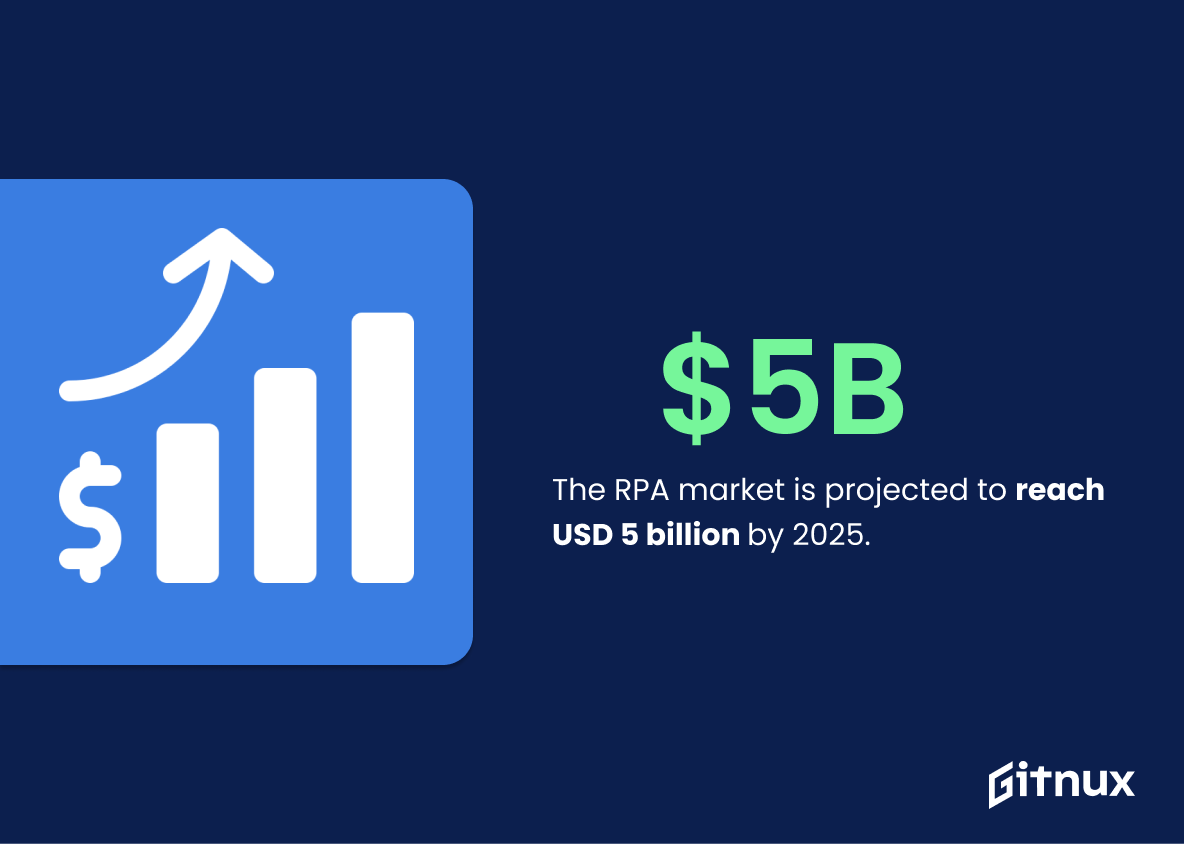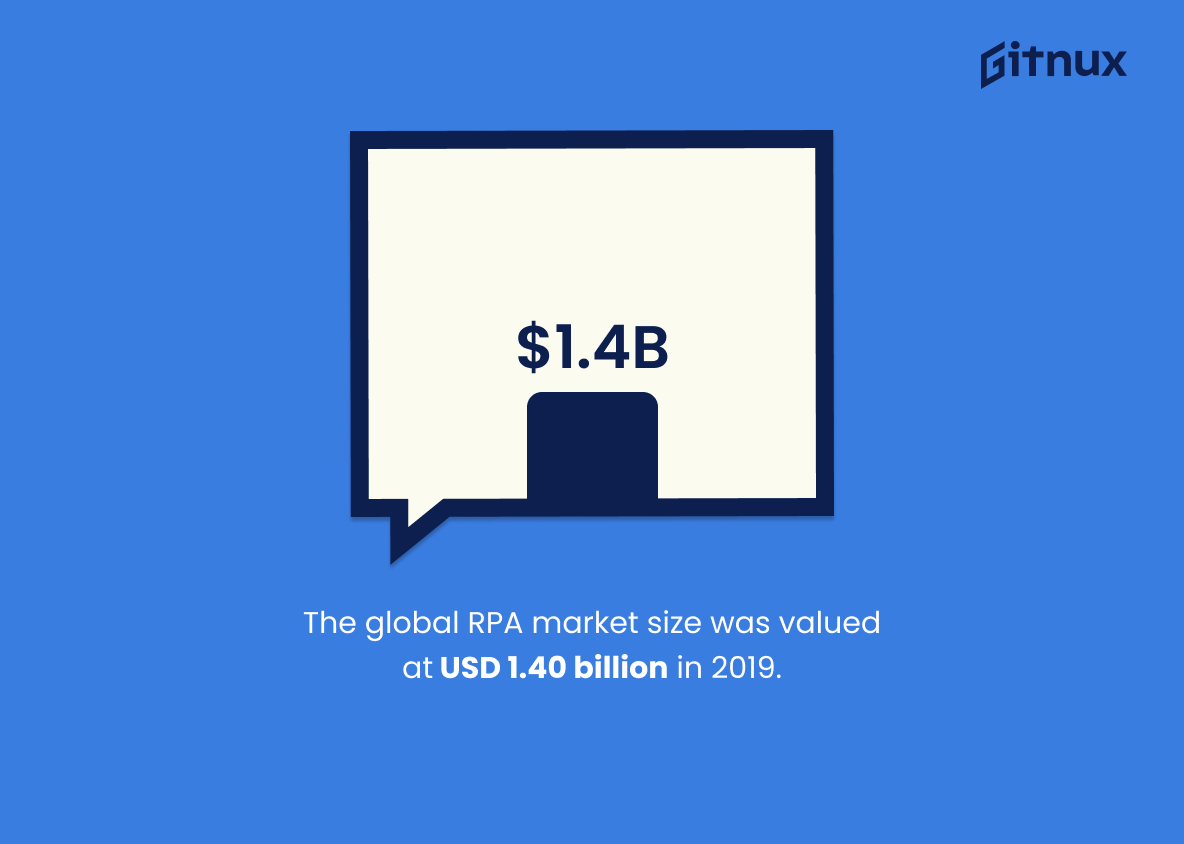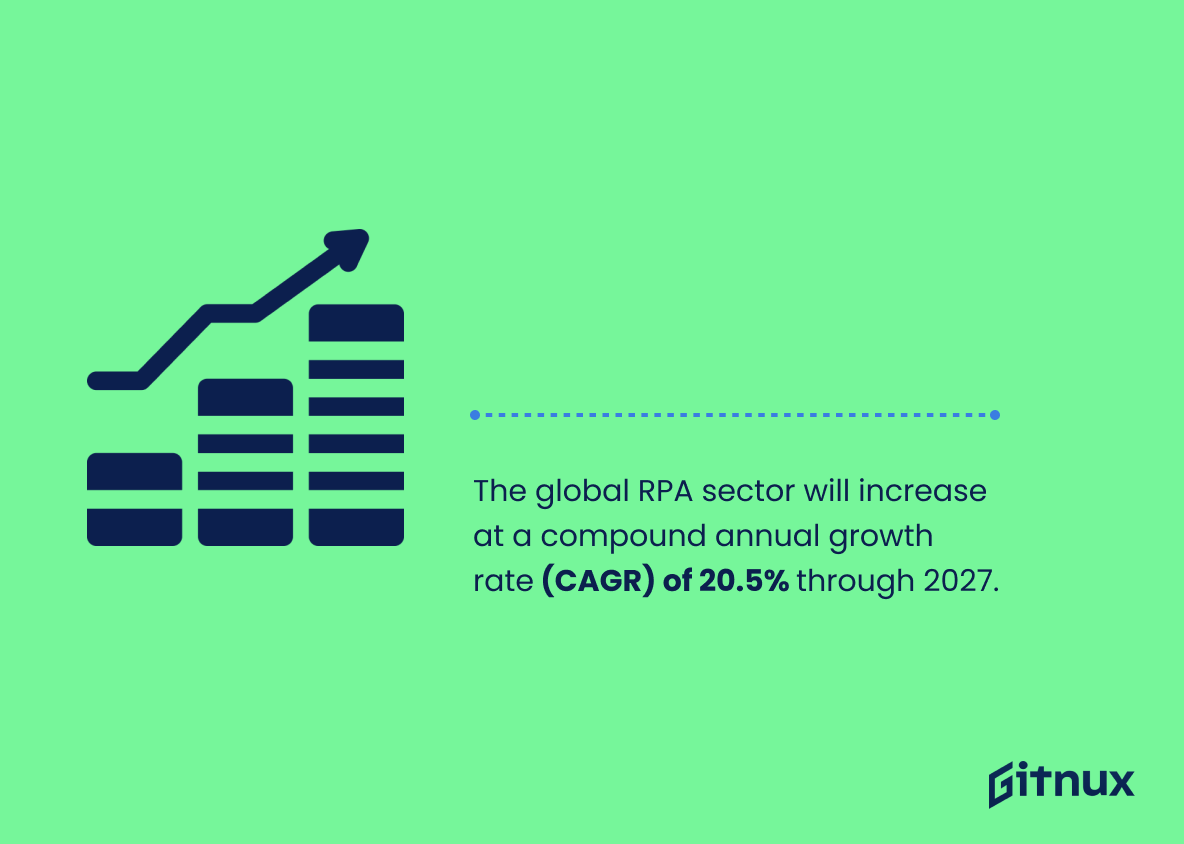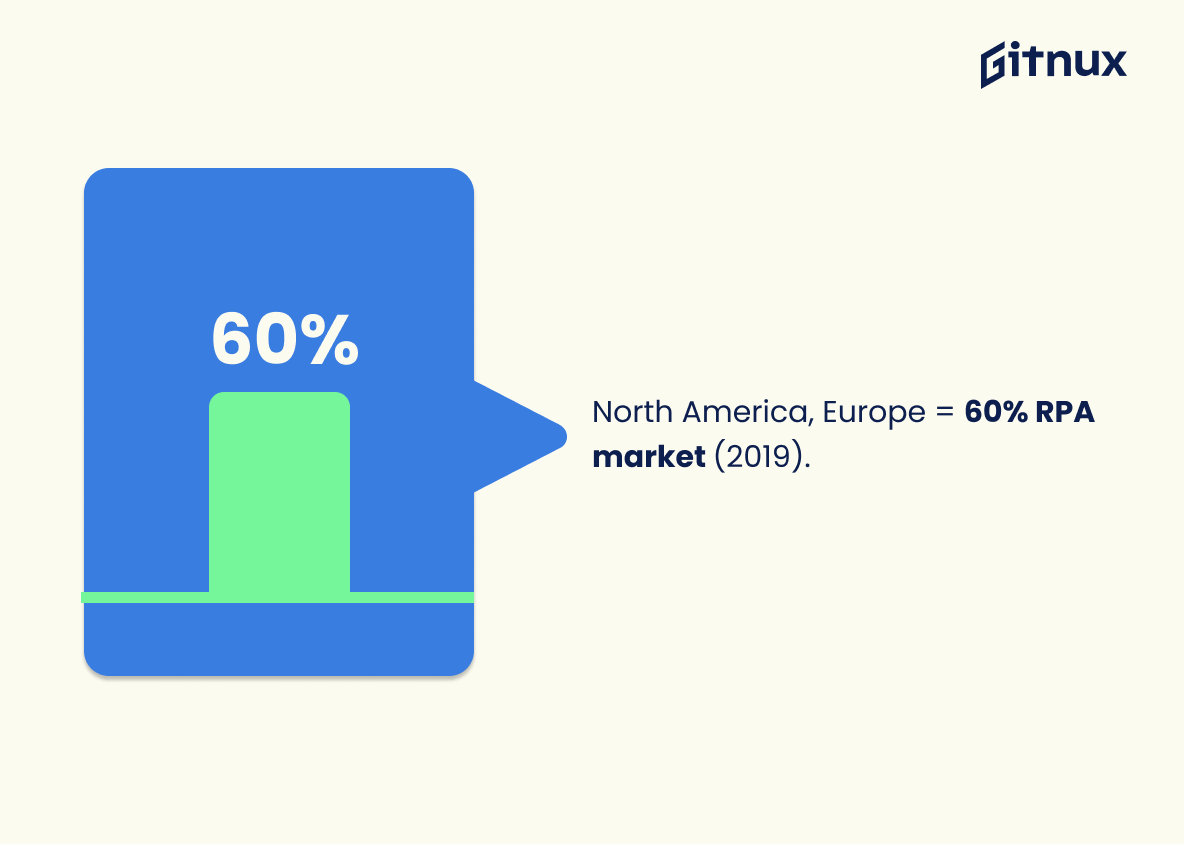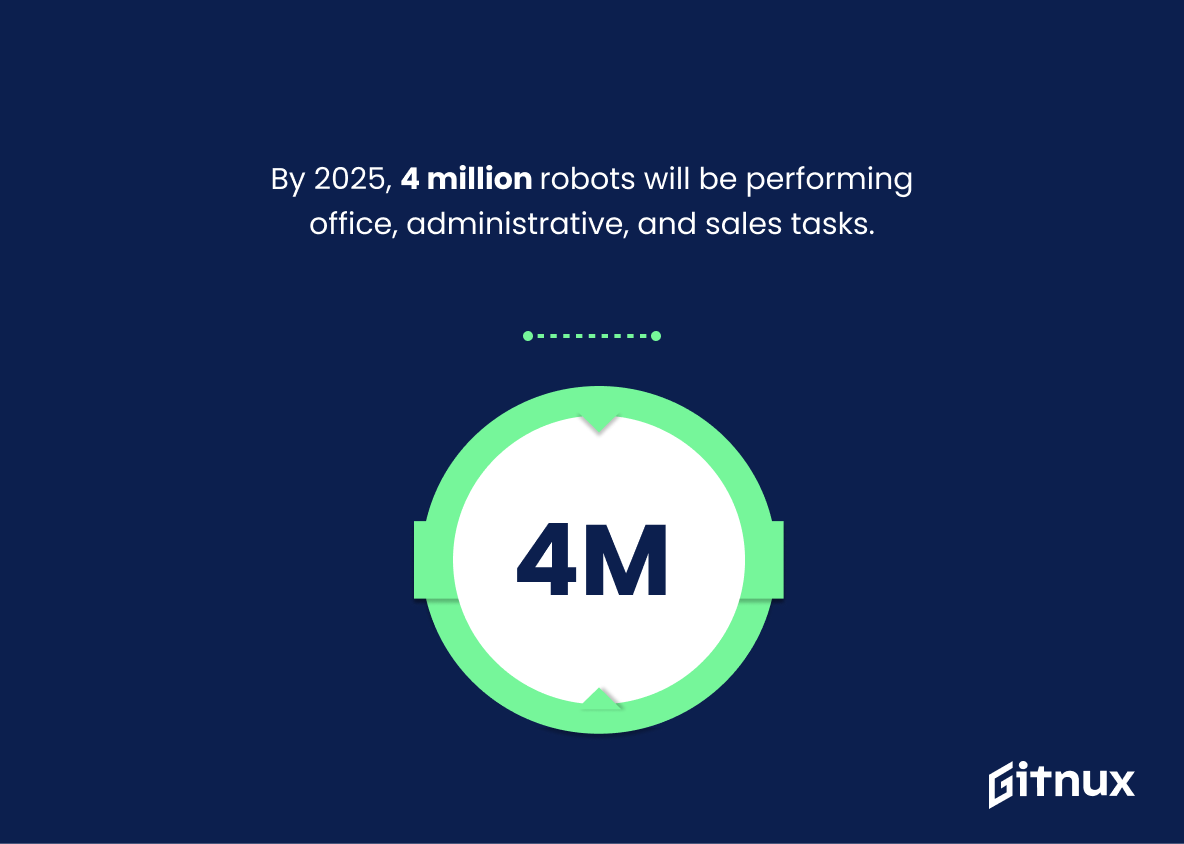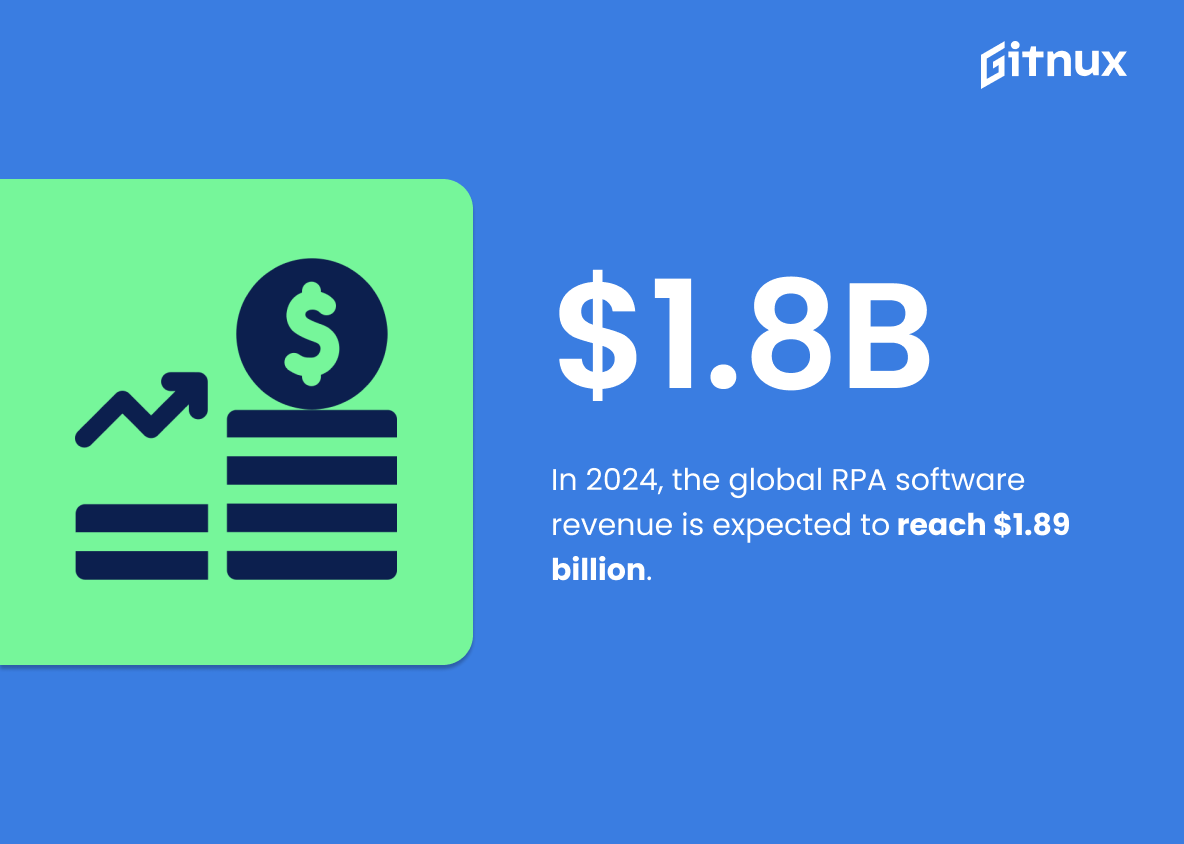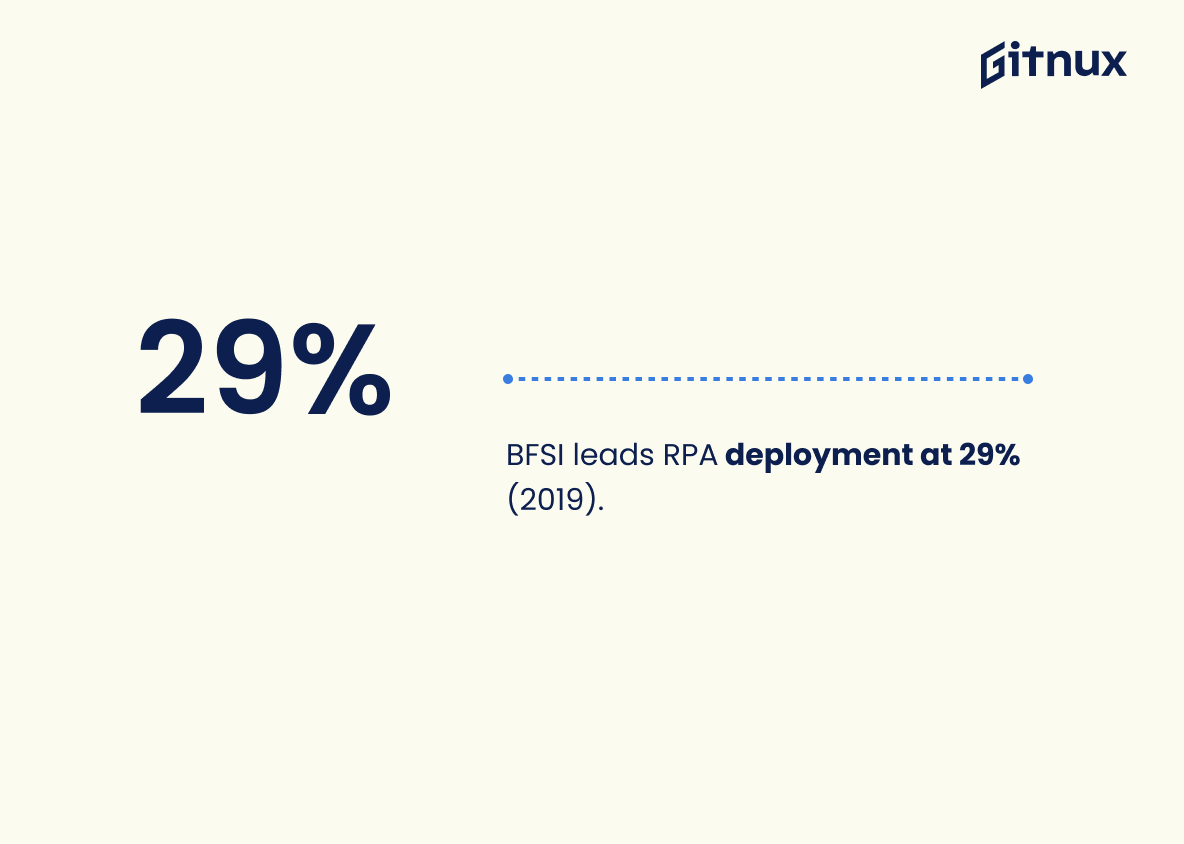As we delve deep into the digital era, RPA (Robotic Process Automation) revolutionizes it by automating routine tasks and supporting businesses in driving efficiency and productivity. RPA technology is reshaping the landscape across industries, dramatically changing the way firms operate, creating remarkable growth trajectories. In this blog post, we will walk you through the most up-to-date and compelling RPA Industry Statistics.
By keeping you abreast of the latest trends, growth rates, market sizes, and more, we aim to provide a comprehensive outlook on the increasingly significant role that RPA is playing in the global economy. Buckle up as we explore the captivating world of RPA and its staggering growth driven by digital transformation.
The Latest RPA Industry Statistics Unveiled
The RPA market is projected to reach USD 5 billion by 2025.
Startlingly, the projection of the RPA market to balloon up to a whopping USD 5 billion by 2025 prompts us to delve deeper into the meteoric rise of this industry. This forecast not only signifies the growing acceptance and adoption of RPA technologies globally, but also highlights the exponential growth potential of the sector. A revelation like this, in a blog post discussing RPA industry statistics, serves as an ideal indicator of the dynamism and vitality of the RPA scene.
Furthermore, it underscores the massive opportunities that are likely to emerge, potentially spurring both entrepreneurs and investors to venture into this goldmine of a market. This statistic is a potent testament to the transformative power of RPA, setting the stage for a future where automation becomes a top agenda for businesses across diverse sectors.
The global RPA market size was valued at USD 1.40 billion in 2019.
Unveiling the immense potential of the RPA industry, this impressive figure of USD 1.40 billion in 2019 underscores the substantial financial footprint that it has cast globally. This vast valuation serves as a vivid testament to the pervasiveness and acceptance of automation technologies. Surpassing the mere realm of niche technologies, it sets the stage portraying RPA not only as a disruptive innovation but also a driving economic force within the global marketplace.
The flourishing RPA market size fosters numerous conversations around growth dynamics, competitive opportunities, and future trajectory, making it indispensable for a meaningful dialogue around RPA Industry Statistics.
The global RPA sector will increase at a compound annual growth rate (CAGR) of 20.5% through 2027.
The aforementioned statistic serves as a powerful compass, guiding us towards the future of RPA (Robotic Process Automation) industry. Showcasing an impressive CAGR of 20.5% until 2027, it offers a critical insight into the evolving landscape of this industry. It not only emphasizes the industry’s resilience but also attests to its potential as a hotbed for technological innovation and investment.
The surging growth rate is a testament to the increasing acceptance and investment in RPA technology across diverse sectors, reiterating its pivotal role in the digital transformation journey of organizations worldwide. Furthermore, the prospective investor, consumer or industry innovator can leverage this information to sketch the roadmap for their ventures or augment their existing strategies, paving way for successful embarkment on the RPA bandwagon.
Developed regions like North America and Europe held 60% of the overall RPA market share in 2019.
Holding a magnificent 60% of the RPA market share in 2019, North America and Europe unequivocally underscored their dominance on a global scale. Not merely a numeric testament, this percentage is eloquent of their technological prowess, adaptability, and investment potential in Robotic Process Automation.
In the canvas of the larger narrative around RPA Industry Statistics, this detail plays a crucial role in illuminating the market geography and pointing towards the regions leading the RPA evolution. Understanding such distribution is invaluable for stakeholders, investors, and enthusiasts alike, as it shapes decisions pertaining to market entry, expansion, and product development.
By 2025, 4 million robots will be performing office, administrative, and sales tasks.
Highlighting the projection that by 2025, 4 million robots will be performing office, administrative, and sales tasks, adds a fascinating layer of depth to the discourse on RPA industry dynamics. This prediction underscores the rapid proliferation of automation technology in corporate landscapes. It amplifies the imminent transformation in office environments, where humans and software bots might work shoulder-to-shoulder, or rather code-to-code, to accomplish everyday tasks.
For businesses that are technologically on the fence, this statistic offers an intriguing glimpse into the future—a future where investing in RPA technology could be more the norm than the exception. It’s not just a number—it’s the heartbeat of the foreseeable revolution in how we perceive and interact with the corporate world.
In 2024, the global RPA software revenue is expected to reach $1.89 billion.
Highlighting this forward-looking statistic offers a fascinating glimpse into the anticipated expansion of the RPA industry. By showcasing an impressive global revenue forecast of $1.89 billion for RPA software alone in 2024, we underline the fact that this technology isn’t just a fleeting trend. As such, it emphasizes the immense potential for growth and profitability within the sector. This, in turn, underscores why professionals and businesses alike should pay close attention to the RPA industry’s trajectory and potential opportunities it could offer.
The United States holds the highest share in the RPA market, with 52% in 2019.
Emerging from this intriguing statistic is the irrefutable dominance of the United States, commanding a monumental 52% of the RPA market in 2019. Without a doubt, this finding brings to light the crucial role of the United States in shaping the landscape of RPA industry.
Emblazoning the country’s position as a global frontrunner, this particular data point lays the groundwork for keen introspection of the nation’s winning strategies, market trends, and growth trajectories in the blog post. In totality, this statistic serves as a compass for creating future narratives within the RPA Industry statistics post.
The BFSI (Banking, Financial Services, and Insurance) sector holds the leading position in the deployment of RPA, with 29% of total market share in 2019.
Highlighting this statistic provides an insight into the trend spotting within the RPA industry. It unveils the domination of the BFSI sector in reaping the rewards of automation technology; indicative of this sector’s inclination towards modern technologies and strategies. Essentially, a 29% share underlines how RPA’s benefits resonate with the inherent requirements of the banking, financial services, and insurance sectors.
These sectors, being data-intensive, procedural, and regulation-driven, make the most of RPA’s forte. In the backdrop of this 2019 statistic, we can anticipate the future trajectory of RPA adoption across industries, foreseeing which sectors might join the early adopters like BFSI.
On average, enterprises using RPA have reported a 60-80% decrease in the turnaround time for their processes.
Highlighting this particular statistic in a blog post on RPA industry statistics shines a spotlight on the profound impact of Robotic Process Automation on operational efficiency. It showcases how the implementation of RPA technology can fundamentally revolutionize business practices by drastically reducing process turnaround times.
With a striking 60-80% decrease, businesses can enjoy a significant edge in productivity, agility, and time-to-market. Therefore, this information serves as a compelling reason for enterprises hesitant about embracing RPA to reconsider, potentially inspiring a wave of digital transformation across the industry.
An average of 20% full-time equivalent capacity is gained in enterprises that have adopted RPA.
Envisioning the thrilling world of Robotic Process Automation (RPA), our statistic brings to light a robust, indisputable business advantage that simply can’t be overlooked. The illustration that an impressive average of 20% full-time equivalent (FTE) capacity is gained in enterprises that have adopted RPA paints a vivid picture of efficiency and productivity.
This statistic powerfully stresses the profound impact of RPA on an enterprise’s operational capacity, validating the technology as a pivotal contributor to the financial and operational improvement objectives. In the grand scheme of RPA industry, this metric serves as a promising beacon, guiding companies that strive for optimization and signaling the expansive potential that RPA holds in revolutionizing business processes.
The highest growth rate for RPA in terms of industry-wise segmentation is the Telecom & IT sector, predicted to grow at a CAGR of 33% from 2020 to 2027.
Unveiling this statistic adds a dynamic layer to the narrative about the RPA (Robotic Process Automation) industry. The sparkling prospects of Telecom & IT sector, which is predicted to surge at a CAGR of 33% from 2020 to 2027, signals an impressive momentum for RPA in this specific industry segment.
This growth rate, being the highest among industry-wise segmentations, heralds a new era of opportunities, challenges, and transformations in both the Telecom & IT sectors and RPA providers serving these sectors. Thus, it serves as a beacon for the future pathway of RPA, offering insights to industry specialists, investors, and interested readers about where the maximum growth is likely to occur in the coming years.
According to Deloitte’s RPA survey, 53% of respondents have already started their RPA journey.
Delving into Deloitte’s RPA survey, a statistic pops out that paints an intriguing picture of the current landscape of the RPA industry. It can be seen that 53% of the surveyed individuals have already embarked on their journey in the automation odyssey. This numeric highlight is a beacon of the burgeoning trend, showcasing not just the adoption, but embracing of Robotic Process Automation technology in various sectors.
It’s a testament to how RPA is not merely a commodity, but rather a necessity in a world propelled forward by digital undertakings and progressive automation solutions. Essentially, the RPA realm is shifting from theory to practice, the vibrant proof of which is this very 53%. Almost like an echo bouncing back from future, signifying the inevitability of RPA becoming a norm for companies around the globe.
This bolsters the reality of the narrative unfolded in this blog post. The statistic enhances the readers’ understanding, providing tangible proof of the RPA sector’s rapidly growing ground in the world of digital transformation.
More than 40% of enterprises will create state-of-the-art digital workers by combining AI with Robotic Process Automation.
Reflecting on the statistic that illustrates how over 40% of enterprises will build cutting-edge digital workers through the amalgamation of AI and Robotic Process Automation (RPA), the implications for the RPA industry are immense. This data point serves as the nexus in a blog post on RPA industry statistics, unveiling an impending transformation in the way enterprises function.
Firstly, it substantiates the increasing adoption of RPA technologies, underscoring the traction they are garnering in the business world. It also echoes the growing comfort level and confidence among corporations to invest in technologies that inherently modify their traditional operational landscapes.
Secondly, it articulates a promising growth potential of the RPA market, which is certainly beneficial for current market players and prospective entrants. It helps them project future growth trends and align their strategies accordingly.
Lastly, the focus on the combination of AI and RPA underscores the trend towards enriched automation possibilities. By integrating AI’s intelligence with RPA’s operational dexterity, businesses are not just automating tasks but are capable of making data-driven decisions, improving efficiency, and innovating their services. Therefore, the fusion of AI and RPA is the beacon that guides the future direction of automation evolution.
In essence, within the panorama of a blog post dissecting the RPA industry’s statistical landscape, this statistic is a powerful milestone underscoring the evolution, growth, and transformative potential of the RPA industry.
The top five RPA vendors based on the 2019 market share are UiPath, Automation Anywhere, Blue Prism, NICE, and Pegasystems.
Delving into the Robotic Process Automation (RPA) industry, one cannot overlook the pivotal statistic highlighting the lead players: UiPath, Automation Anywhere, Blue Prism, NICE, and Pegasystems, as per the 2019 market share. In the blog post, this data paints an enriching, detailed landscape of influential forces shaping the industry’s direction.
The identified frontrunners arguably serve as the spearheads of innovation, driving trends and setting benchmarks for competitors. They are also essential when observing the industry’s competitive dynamic, offering insights into the strategies employed by successful businesses in the market. Thus, by studying these vendors, we can discern patterns and tactics that might be instrumental for emerging and established players alike.
Furthermore, understanding how these companies have capitalized on the RPA trend provides a glimpse into customer preferences and dominant offerings in the market. This, in turn, can act as a foundation to anticipate future market movements, relaying vital knowledge to investors, stakeholders, and businesses contemplating entry in the RPA market.
In the broader context, the prominence of these companies in the RPA industry is a testament to the industry’s growth potential and the increasing importance of automation in our digital-era businesses.
According to a survey by EY, 30% of respondents have implemented RPA on a small scale, while 2% have implemented it at scale (more than 50 robots).
Delving into the intriguing world of Robotic Process Automation (RPA) industry statistics, one cannot overlook a key metric disclosed by an EY survey. As per their findings, a significant 30% of the respondents confessed to tiptoeing into this rising technological trend, implementing RPA on a minimal scale. Meanwhile, a brave 2% have inched ahead of the curve, putting more than 50 robots into action.
This revelation from the survey is akin to looking into a crystal ball, providing key insights into the nascent yet quickly evolving stance of organizations towards automation technologies. It highlights the demographic of early adopters while shedding light on the trepidations and uncertainty that dissuade the majority from fully embracing this trend.
Moreover, the bold leap taken by the small 2% meanwhile, potentially captures a glimpse into the future, a testament to the potential scale and magnitude this technology can achieve in the days to come. Continuing to monitor this trend could provide valuable insights into the speed and direction in which the RPA industry is progressing.
Conclusion
In conclusion, the RPA industry is skyrocketing at a remarkable pace. The statistics we’ve reviewed showcase the impressive growth, sustainability, and potential of this sector. Its impact spans across multiple industries, making it a game-changing technology with the capability to enhance operational efficiency and productivity.
As more organizations realize the benefits, adoption is set to rise significantly. Current predictions estimate a highly valuable market in the coming years, suggesting that RPA will not only continue to trend but will become an integral aspect of business operations. For businesses aiming to maintain competitiveness and achieve digital transformation, understanding and leveraging the power of RPA should be a top priority.
References
0. – https://www.www.emergenresearch.com
1. – https://www.www2.deloitte.com
2. – https://www.www.gartner.com
3. – https://www.www.forrester.com
4. – https://www.www.prnewswire.com
5. – https://www.www.statista.com
6. – https://www.www.grandviewresearch.com
7. – https://www.www.weforum.org
8. – https://www.www.ey.com
9. – https://www.www.alliedmarketresearch.com
10. – https://www.www.fortunebusinessinsights.com
